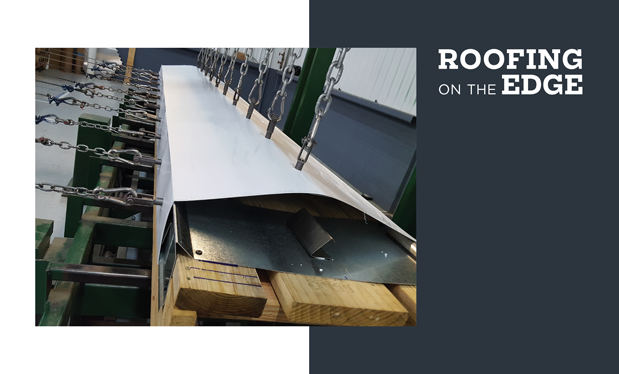OSHA provides new silica standard resources
The Occupational Safety and Health Administration (OSHA) has made available new frequently asked questions (FAQs) and training videos regarding the agency's standard for respirable crystalline silica (RCS) in construction at www.osha.gov.
Developed by OSHA in cooperation with industry and labor organizations, the FAQs provide employers and workers with guidance regarding the standard's requirements. In addition, a series of six new videos instruct users regarding methods for controlling exposure to silica dust when performing common construction tasks or using construction equipment; the videos address topics such as handheld power saws, jackhammers, drills and grinders.
NRCA has compiled OSHA's FAQs in a PDF format accessible by clicking here. For more information and resources regarding compliance with OSHA's silica standard, click here.
NRCA has been conducting personal breathing zone sampling on roofing job sites where silica may be present to assess worker exposures to RCS. This effort is intended to establish roofing industry objective data contractors can rely on, particularly when performing tasks not listed in Table 1 of OSHA's regulation. Industry objective data can relieve contractors from the expense of conducting their own sampling if the tasks being undertaken are similar to those found in the objective data. In most of the sampling conducted on asphalt shingle, polymer-modified bitumen and built-up roofing tear-offs and installations, exposures not only were below the permissible exposure limit (PEL) but also below the action level and in many instances below the limit of detection. Levels of total respirable dust also were well below the OSHA PEL.
In addition, sampling was performed on tasks such as drilling into concrete or masonry for fastener attachment, cutting and fastening gypsum roof boards, and installation and removal of roof gravel or ballast—all with equally positive results.
NRCA offers explanatory material and summaries of the sampling reports in the Members Only section of its website, as well as Toolbox Talks regarding RCS in English and Spanish; a customizable sample written silica exposure control plan required by OSHA's standard; a sample written respiratory protection plan; and links to other resources that may help with compliance. NRCA's silica regulation resources are available by clicking here.
More reports will be added to the silica regulation resources section as NRCA continues to conduct sampling on additional roofing projects.
IRS issues small-business accounting methods guidance
On Aug. 3, the Internal Revenue Service (IRS) issued guidance regarding small-business accounting method changes under the Tax Cuts and Jobs Act (TCJA) of 2017.
Enacted in December 2017, the TCJA expands the number of small-business taxpayers eligible to use the cash method of accounting beginning after Dec. 31, 2017. The IRS guidance explains the process by which small-business taxpayers with average annual gross earnings of $25 million or less during the previous three-year period can obtain automatic consent to change accounting methods as permitted under the TCJA. Eligible small-business taxpayers also are exempt from certain accounting rules for inventories, cost capitalization and long-term contracts.
Updates regarding the implementation of the TCJA are available at www.irs.gov/tax-reform.
Construction companies cited after worker's fatal fall
The Occupational Safety and Health Administration (OSHA) has cited Hammers Construction Inc., Colorado Springs, Colo., and Montes Construction LLC, Colorado Springs, after a worker's fatal fall at a job site in Greenwood Village, Colo., according to www.osha.gov. The companies are not NRCA members.
In March 2018, OSHA inspectors investigated the job site where an employee fell while installing metal roof panels on a storage unit building. The construction companies received citations for failing to use adequate fall protection and failing to restrict employees from standing on the mid-rails of scissor lifts. Proposed penalties for Hammers Construction total $97,002, and proposed penalties for Montes Construction total $80,891. Montes Construction previously was cited in January for failing to provide fall protection for employees.
"These employers failed to protect their employees from well-known and preventable fall hazards," says David Nelson, OSHA's area office director for Englewood, Colo. "This tragedy could have been prevented if they had met their obligations and provided the required fall protection."
Hammers Construction and Montes Construction have 15 business days from receipt of their citations and penalties to comply, request an informal conference with OSHA's area director or contest the findings before the independent Occupational Safety and Health Review Commission.
NRCA encourages all members to comply with OSHA regulations to protect employees and avoid possible citations and fines.
DOL will check contractors' affirmative action certifications
The Department of Labor (DOL) announced it will audit contractors who have not certified their affirmative action compliance to the government, according to Bloomberg Law.
Federal contractors must comply with various outreach, recruitment, training and other affirmative action requirements separate from their workplace nondiscrimination obligations. They must currently disclose to the General Services Administration whether they have an affirmative action plan in place or are not qualified to do so. Contractors make their certifications under penalty of perjury and the False Claims Act.
Previously, DOL's Office of Federal Contract Compliance Programs (OFCCP) audited facilities through a random selection process rather than targeting contractors who have not checked the appropriate compliance box. David Cohen, president and founder of Washington, D.C.-based consulting firm DCI Consulting Group Inc., told Bloomberg Law the certification review will allow OFCCP to focus audits on contractors who don't have an affirmative action plan in place.
Mickey Silberman, co-chair for the Institute for Workplace Equality in Washington, D.C., told Bloomberg Law the program should focus the agency's limited resources and will not be a burden for compliant contractors.
"For employers that don't certify compliance, they likely will be prioritized for audit," Silberman says. "That should result in fewer audits of the good employers that do certify."



